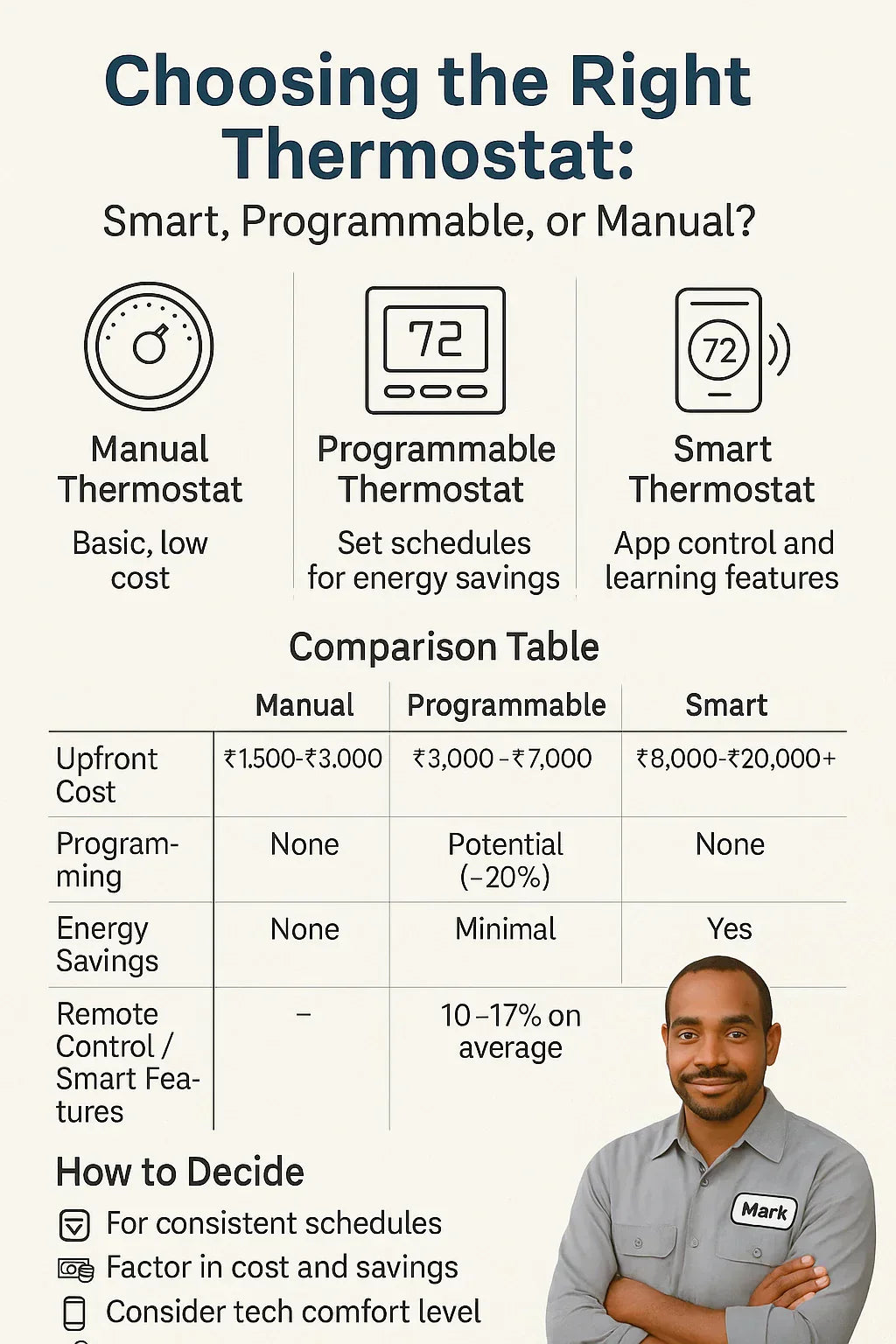By Mark — Your DIY HVAC Companion
Thermostats aren’t just wall dials—they’re the command center for your home's comfort and energy use. Whether you're tech-averse or smartphone-savvy, I’ll help you pick the thermostat type that saves money, keeps everyone comfortable, and matches your lifestyle.
1. The Thermostat Trio — What Sets Them Apart?
There are three main types of thermostats available today:
-
Manual (Analog) Thermostats – Basic, low-cost, no frills.
-
Programmable Thermostats – Let you preset temperature schedules.
-
Smart Thermostats – Wi‑Fi connected, learn your routine, and let you control remotely.
Let’s walk through what distinguishes each type and why it matters.
2. Manual Thermostats — The Old-School Option
Overview & Pros
Manual thermostats are simple, analog or mechanical devices. You turn the dial or press buttons to set the temperature—the system heats or cools until that point is reached, then turns off. They’re inexpensive (often around $15–$40), easy to install, and reliable.
Drawbacks
They offer no automation and require you to adjust them manually whenever your schedule changes—even leaving you vulnerable to forgetfulness that can hike up energy bills.
Mark’s Take
They're fine if your budget is tight and you’re disciplined about manual adjustments—but let’s be real: most of us aren’t setting the temp every time we leave or come home.
3. Programmable Thermostats — Set It & Forget It (If You Remember to... Set It)
How They Work & Benefits
Programmable thermostats let you schedule heating or cooling based on time and day. You can dictate different temperatures for weekday mornings, evenings, weekends, and more. If used properly, they can shrink energy bills by about 20%.
Real-World Flaws
In reality, many people misprogram them—or totally ignore the scheduling feature—so the expected energy savings don’t always materialize. Some studies even show minimal or no average savings.
Mark’s Wisdom
These are a step up from manual—as long as you actually program them and your schedule is regular. But if you want flexibility for changing routines, they’ll make you work harder, not smarter.
4. Smart Thermostats — Your HVAC, the 21st Century Way
What Sets Them Apart
Smart thermostats connect to Wi‑Fi, let you adjust settings via app or voice, learn your habits, and optimize for comfort and savings. They integrate with Alexa, Google, and other smart platforms.
Smart Thermostats vs Programmable Thermostats: What’s the Difference?
Energy Savings That Add Up
Studies show that switching from manual or programmable to smart can reduce heating costs by about 10% and cooling by up to 17.5%. Ecobee claims ~10% gas savings, Nest users reported 17.5% cooling savings.
In head-to-head comparisons, smart thermostats outperformed programmable ones: e.g., Nest delivered ~12.5% gas savings vs ~5% for programmable; cooling savings were ~13.9% vs ~13.1%.
Is a Smart Thermostat Worth It? The Pros and Cons Explained
The Catch
-
Upfront costs range from ₹8,000 to ₹20,000 and above; installation may require a “C‑wire”.
-
You must be comfortable with a bit of tech—apps, Wi‑Fi, and permissions. There’s also a slight privacy trade-off in data collection. Better Homes & Gardens
Mark’s Opinion
If your schedule varies, you value convenience, and you’re building a smart home, this is your best bet. Living outside India? Check compatibility—it varies by region and HVAC system.
5. Quick Comparison Table
| Thermostat Type | Upfront Cost | Programming Required | Energy Savings | Remote Control / Smart Features | Best For… |
|---|---|---|---|---|---|
| Manual | ₹1,500–₹3,000 | None | None | None | Budget buyers; homes with static patterns |
| Programmable | ₹3,000–₹7,000 | Yes | Potential (~20%) | None | Predictable schedules, low-tech convenience |
| Smart | ₹8,000–₹20,000+ | Minimal (auto) | Real-world average: 10–17% | Yes (app, voice, learning) | Tech-savvy users seeking automation & savings |
6. How to Decide — What Fits Your Home & Lifestyle?
As Mark, your DIY HVAC sidekick, here’s how I size things up:
A. Examine Your Schedule
-
Consistent everyday routine? Programmable could work well.
-
Highly variable schedule or many occupants? Smart is smarter—seriously.
B. Budget & ROI
-
Lowest cost? Manual.
-
Long-term savings? Programmable saves a bit, smart saves more and adapts for you.
C. Tech Comfort Level
-
If you avoid your phone, programmable makes sense.
-
If an app sounds fun, smart thermostats offer convenience plus efficiency.
D. Compatibility Check
-
Ensure your HVAC system supports the thermostat.
-
Smart models may require a “C‑wire”—older setups might need a workaround or adapter.
E. Local Support & Incentives
-
Some utilities offer rebates on smart or programmable thermostats. Check local options. The Spruce
7. DIY Installation — What You Need to Know
Most modern thermostats are DIY-friendly:
-
Turn off power to your HVAC system before starting.
-
Label your wires as you remove the old unit—don’t guess.
-
Follow provided manufacturer wiring diagrams carefully.
-
Smart models often need a C‑wire—if you don’t have one, you may need to use an adapter or install it.
-
Test your HVAC controls after powering back on.
When to Call a Pro
-
Complex HVAC systems
-
No C-wire and you're uncomfortable not adding one
-
Prefer avoiding electrical work
8. Final Thoughts — Which Thermostat Should You Choose?
Let’s recap Mark’s advice in two simple questions:
-
Want lowest cost and can manually manage temps? Go Manual.
-
Want automation but have a regular schedule? Programmable fits.
-
Want the most convenience, comfort control, and savings? Smart wins—if you're OK with app usage and a higher price tag.
Summary Table
| Your Priority | Best Choice | Why |
|---|---|---|
| Lowest setup cost | Manual | Least expensive, simple operation |
| Budget-friendly automation | Programmable | Pre-set schedules without mobile app complexity |
| Maximum energy savings + convenience | Smart | Learns habits, remote control, integrates with smart home |
In the next topic we will read more about: Air Filters Explained: Sizes, MERV Ratings & Replacement Schedules







